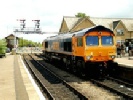Archive Section




28th April 2001
© Text by Tom Chaffin, photo by Graham Vickers

Corrys Test of France built the driver simulator which is an exact replica of a 1996 underground train cab – as used on the Jubilee Line. The 59 trains of 1996 stock were built by Astrom in Washwood Heath, Birmingham (formally the Metro Cammel works) and were delivered between 1997 and 1999. Each train consist of 6 cars and 47 trains are required for operation during the peaks. The 1996 stock are the first London Underground trains with AC traction motors, which operate at 415V. Control of the motors is undertaken by varying the frequency and mark-
Control circuits around the train operate at 52V DC. The train cab, and of course the simulator, features a combined traction and braking controller incorporated into the right hand arm of the driver’s seat. An encoder within the seat reads the position of the control handle optically. The red control handle is sprung so as to return to being parallel with the drivers seat and so has to be twisted away from this position all the time the train is moving, otherwise the train brakes are applied automatically – the same function as a conventional deadman’s handle. Braking is achieved by moving the handle towards the driver, the nearer the higher the braking force. Moving the handle away from the seat a distinct click is felt as the ‘coast’ position is reached followed by progressively higher traction power being applied as the handle is moved further away.
Two split-
Most commonly used control switches, such as door opening buttons, are conveniently located in front of the driver and less used switches, such as for train lights, are placed above the drivers left shoulder. Various circuit breakers for equipment isolation are located behind the driver, whilst on the far offside of the cab, but easily viewed from the drivers sitting position, a train diagnostics and information panel is fitted. Also on the offside, behind a hinged access door below the desk and next to the central detrainment or "K" door is the tripcock realise cord, which compared to everything else in the cab seemed rather old fashioned, consisting simply of a handle attached to a wire cord which disappears under the train down a metal tube. As we were soon to discover, this has to be pulled up sharply to reset the trip-
In the simulator the route of the Jubilee line is viewed out of the front windows of the cab. The simulator can reproduce the whole of the Jubilee line in either direction. Poor weather conditions such as fog can be simulated and various ‘incidents’ can also be reproduced such as signals changing to red aspects immediately in front of the driver, poor adhesion conditions and various on-
I was fortunate enough to be given a chance to drive the simulator a few stations after being given a demonstration by an instructor. No sooner had I started the train before the tripcock apparatus stopped me. This was reset by pulling the tripcock realise handle sharply, which realised the brakes but also reduced the speed significantly for a couple of minutes, which is a feature introduced to stop over-
When driving the simulator myself, I was surprised at the amount of force that I considered was required to keep the control handle twisted and prevent the deadman’s taking affect; so my knuckles were turning white with the effort. Apparently this is typical of trainee drivers, but in time it is learnt that much less force is required and a more relaxed driving position can be adopted.
On the Jubilee line, as well as other Underground lines a right-
|
If you have enjoyed this article, you may also be interested in the following related L&CI visits: |
|
|
Tour of the Metropolitan Lines of London Underground behind 1923 vintage electric locomotive Sarah Siddons, also on 28th April 2001 and |
|
|
|
The Jubilee Line Control Room at Neasden, also on 28th April 2001 and |